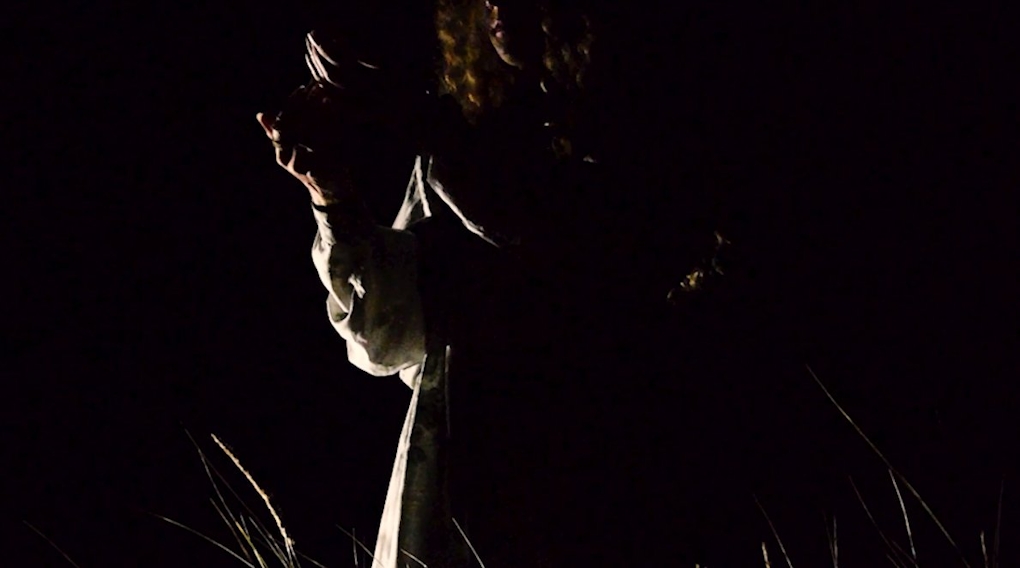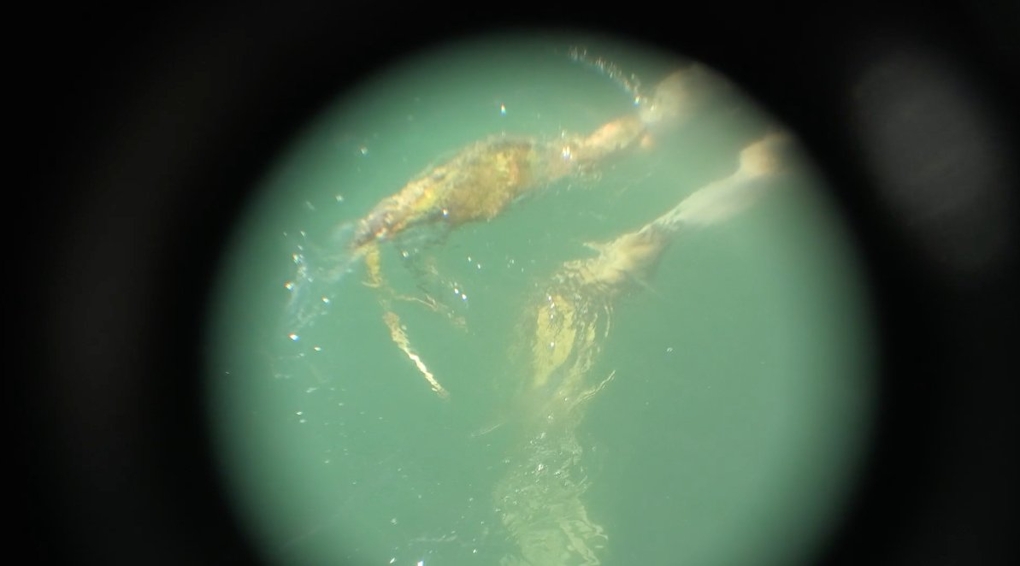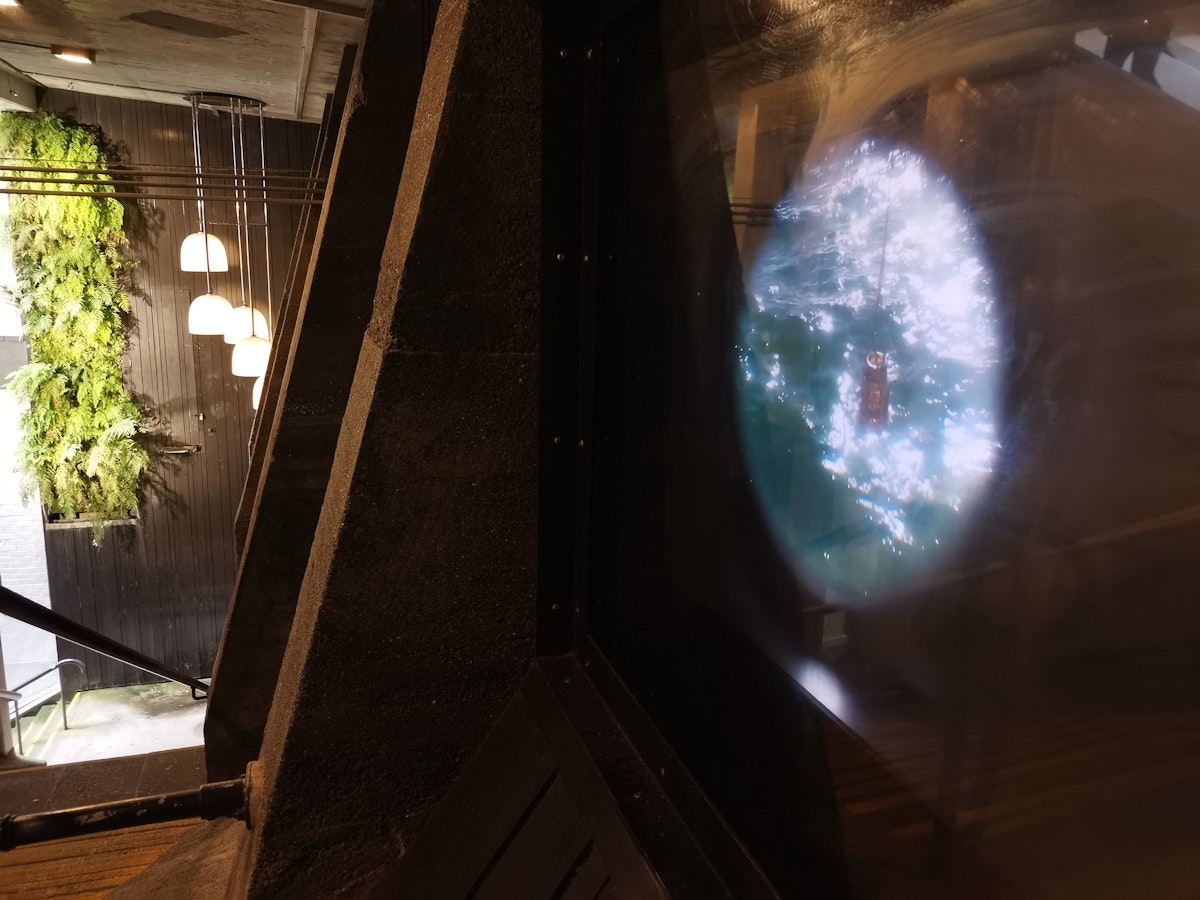It’s been a hard time. Can the subject be avoided? Really, it’s impossible to talk about these works without acknowledging the events that have occurred beyond the edges of Masons Screen.
This end of town’s been weird as hell—desolate and abandoned, then invaded by protesters, stormy and flooded, then contested, subject to imported and local rage and paranoia, then empty again as hissing steam and oil-slick puddles evaporate, slowly, upwards, from torn-up street cobbles. I’m sure you’re sick of it. I’m sick of it too. But it’s impossible to see this contested area without the mediating lens of the global pandemic, and all its attendant terrors. The “containment of our natural wetness and the careful release in socially permitted-and-constrained circumstances” is a more present concern than ever: fear of wet transfer, water droplets expelled by breath and hung in the air, leaves us waiting for things to be “normal” again, whatever end or corner of the ideological divide.1
In a peripheral laneway, where the swirling currents of office workers have slowed to a trickle, a figure walks through the tall grass across Masons Screen, carrying a talisman twined with rope. In this work, Mana tipua tuku iho ~ Transcestor (2021), by Louie Zalk-Neale, the vessel, poured upward into the hand, defies common physics: water, after all, can go up as well as down. One wonders if the jar contains flying ointment, which might account for the fractious, shimmering visual slippage as the sorceress-like figure turns and retreats through the long grasses. Then we emerge as if from the bottom of a well, or looking up through a periscope, or simply through water itself: thick, green and opaque, solid in the way that air is not. Perhaps we can imagine the long, baleful stare of a slow-moving sea creature from the depths, their viewpoint occluded by the choppiness at the surface. At the last, earthly fins rise up and wink out of the frame.
The central figure, backlit, face not visible, undergoes a state-change: from witchy forest-swamp being, casting wishes into the night, through to a hazy, waterborne clump of tendrils, golden, evasive and vaguely biological.

Still from Mana tipua tuku iho ~ Transcestor (2021) Louie Zalk-Neale
In both states this figure elides the viewer; in both states, they are turning away, refusing to be captured or known. Here, Zalk-Neale is calling on the legend of Ngake and Whātaitai, twin taniwha of the Pōneke harbour. As the story begins, briefly: Ngake and Whātaitai were enclosed in the harbour of Te-Whanganui-a-Tara, which back then was a lake. The sea birds, as they passed by, told the brothers of the vastness of the ocean. The taniwha longed to explore the sea, and eventually Ngake made a break for it, blasting through the cliffs that hemmed them in and creating Te Moana o Raukawa (Cook Strait) in the process. Whātaitai, however, was beached on a sandbank by the low tides, and could do nothing but wait, stranded to his fate.
I don’t think that Ngake is present in Zalk-Neale’s work except as an absence; this is the story of Whātaitai, and how they were left behind, landlocked and stricken with grief, until a vast rupture2 occurred and they were transformed through death into Te Keo, a female bird. A water-breathing creature forced into the distressing heaviness of being landbound, which then becomes an air-breathing flighted creature; solid matter is spun up into vapour, a transubstantive3 response to its own questioning call. How must that have felt? Did Whātaitai rejoice as they were released from their yearning, finally able to leave the painful, uncaring harbour behind? A transformation—or, more correctly, sublimation—of this scale is bound to hurt, whether physical or deep within. Much like the passage of gifts, it depends on time as its clarifying force: the interstitial space, the work of waiting, brings the conditions for the transformation to occur.4 Zalk-Neale uses the story of Whātaitai as a tool to situate themselves within a lineage of takatāpui revelation, acting out the journey of their tupuna, whose waiting was not in vain.

Still from Mana tipua tuku iho ~ Transcestor (2021) Louie Zalk-Neale
A pause for breath, a break for a spell. Gabriel White's Scenic Journey (2022), removed from the action barely a block away but still uneasy with proximity, plays on Masons Screen to a gap where an observer should be. They are at home, waiting this one out, and not without irony: White filmed this work at sites of industry in the Wairau Valley that were abandoned during the 2021 Covid-19 lockdown. The film opens with the central figure repeating a classically Sisyphean gesture, struggling to push a heavy dumpster up the steep inclines of an industrial carpark and repeatedly losing ground. As a reluctant bureaucrat, this feels kind of personal, actually. The dilation of time during the Covid-19 lockdowns felt slow, acute, and confounding, and often like trying to walk—or think—through mud.
In their article Shame, subjectivity, and pandemic productivity5, Dr. Gwyn Easterbrook-Smith discusses the commonly-held assumption that lockdowns produce “spare time” for the individual, and the attached supposition that this “free time” could be leveraged as an opportunity for productivity and self-improvement.5 Easterbrook-Smith asserts that this ignores barriers such as class, means, the demands of gendered labour, and the realities of the collapse of work/leisure, home/work boundaries, in favour of unfettered individual responsibility and the neoliberal drive of relentless optimisation, limitless growth. Never mind that most of us, even those privileged enough not to be squeezed by medical, financial, familial, or spatial concerns, were simply trying to get through it, not learn a new language or rewrite King Lear.6 The relentless push towards self-improvement suggests that we’ll never be worthwhile as we are now—if we stay the same, or if we achieve nothing, are we still worthy of attention, concern, respect, care? Do we cease to mean if we aren’t doing anything?
White is doing something, and what he is doing is—nothing.
Scenic Journey (2022) Gabriel White
This doesn’t mean he ceases movement. Measuring the environment using the body, unthrowing trash into another dumpster, staring down at himself into a flooded ditch—that self also occupied with crawling, in reflection, on the surface of the water, while yet another self farts around with the skeleton of a billboard at stage right. So, he is doing something. But none of it butters any bread, or has any meaning to the wider ideals of productivity at large. The deliberate activity of doing nothing is reflected in Heidegger’s concept of Gelassenheit, which is a sort of waiting-without-waiting, doing-without-doing, literally translated as releasement.
I’m reminded, by both gelassenheit and White’s lazy syncopated waving from behind the Atlas concrete fence, of Shoji Morimoto, a thirty-eight-year-old man in Japan, who’s gained fame by hiring himself out as the Do-Nothing Rent-A-Man. Morimoto has been paid to eat birthday cake with someone, to accompany people on shopping trips, stand in queues, and turn up at the train station to wave goodbye to travellers. He has turned down tasks that might be considered more “gainful”, for example cleaning houses, doing laundry, or even providing advice beyond very neutral conversation. It’s a little ironic to commodify “doing nothing”, but also stresses the point that “doing nothing” is never really doing nothing. As one commentator muses: “I think it’s actually very hard work, to be there but be totally detached, not get affected emotionally, only respond neutrally, be like air basically.” Some might mistakenly think of air as “doing nothing”, too. White, conditionally released from “productivity”, has in fact been rather industrious.
The final video in this series of new commissions for Masons Screen is Wai whakaika (2022), by Jamie Berry, a paean to three streams—Kumutoto, Tutaenui, and Waipiro—which flow beneath Wellington’s CBD. This work pairs well with Zalk-Neale’s, being similarly grounded in the history of the Pōneke landscape.
In Wai whakaika the water drips, trickles, erupts outwards, collapses in on itself. Streams cross the screen longways and crosswise, refracting into blinding vanishing points. The three stylised female figures, with their seven heads, a row of fourteen gimlet eyes, gaze out at the viewer, while abstract and material flows cascade down the frame, or erupt upwards and outwards, bounding from wild axes of reflection. It’s at once peaceful and never at rest. The accompanying soundscape rises and calms, overlaying birdsong with a percussive rattle and the chuckle of water flowing. Air bubbles are provoked by the churn of currents, and the downward coursing of the lines and lattices leaves the distinct impression of tukutuku panels, or the track of tears.
Wai whakaika (2022) Jamie Berry
Waipiro translates to stinking water, and also alcohol.10 Kumutoto means bleeding from the behind, which is alarming without context, but refers to a tapu site where women went to labour and give birth.11 Tutaenui translates politely to a place for a big gathering or, more popularly, big shits. Along with the site of childbirth at Kumutoto, the wāhi tapu between Waipiro and Tutaenui was used for burial platforms, and neighbouring streams served various activities such as healing, bathing, and the growing of food.12 Many of these streams have been piped over the last century or two (guess who by!) and some even demoted to the ignoble status of drains.13 The mouth of the Kumutoto stream was only recently uncovered to allow its release into the harbour, after first being culverted in 1866.14
The three lines of Kumutoto, Tutaenui and Waipiro, drawn impalpably through an underground landscape, are part of a network that demarcates the imprints of sacred bodily actions—birth, death, substances that are taken in or emanate from the body. Watery concepts underpin much of mātauranga Māori. For example, the phrase “te taha wairua” refers to both the spiritual plane and the “real world”, translating literally as the dimension of two waters.15 “The word “tangi” translates as “to weep” and one of the tangi’s repeated proverbs is “Me nga roimata me te hupe ka ea ai te mate” which is commonly translated as “by tears and mucus death is avenged.”16
Berry’s practice has a long-held affinity with water. Previous works consider the “memory of water”, a gentle pseudoscientific theory from Dr. Masaru Emoto, in his book The Hidden Memory of Water (2004), which extends from the confabulations of homeopathic study. The idea is that if you say kind words to water, it will form beautiful crystalline structures; if you direct negative attention towards it, the structures will be “ugly”. It’s not totally without merit. Water knows that it should evaporate, return to the atmosphere, come down again to feed the water table, rush through streams to the ocean; it “knows” of itself as partial expression of a wide-ranging, dispersed body. It carries various messages, not all of which we can read. To ascribe sentiment to this process is rather beyond the point of knowing.
Contemplating the lineage of water provokes interesting consideration of the hydrosphere itself. “Often in the west, water seems more temporary than time and space, as though water’s more intense substantiality is an inverse sign of its evanescence.”17 This elides its ongoingness, how it exists less as a temporal substance that is here one moment and gone the next, but more conceiving of it as moving parts of an entire entity. Samuels discusses “loosenings of the body's liquid boundaries” as a continuous social expression, rather than the dryness of containment: wetness as looping fluid transfer, ceremonial, ancient. The body, a container of water and other things, breathes out water as vapour, takes it in through the eyes, nose, and mouth and expels it; skin-barriers effect only a token separation from the larger, ineffable hydrosphere, comprising three states of solid, liquid, and vapour, and full of fundamentally the same substance as that which courses through the ground beneath us. “I am the water the water is me.”18 Conceiving of the self as but a bit-player within the water cycle necessitates a radical shift in scale—and attitude. Acknowledging the mana of our waterways, as Berry has done with this empathetic karakia, is a good place to start.
In all three works on Masons Screen there’s a push-and-pull between patience and impatience, plays on reversal, deep time, circulation. It’s reassuring to think that the water darkening the torn-up paving stones of the city’s streets will filter back into the water table, evaporate upwards into the sky to feed into the streams that rattle through the ground beneath us. Patience. We continue to wait, as time continues to flow.
